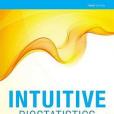《Intuitive Biostatistics》是Oxford University Press出版的圖書,作者是Harvey Motulsky
基本介紹
- ISBN:9780199946648
- 作者:Harvey Motulsky
- 出版社:Oxford University Press
- 出版時間:2013年12月13日
- 頁數:576
- 定價:USD 69.95
- 裝幀:Paperback
內容簡介
Overview Intuitive Biostatistics is both an introduction and review of statistics. Compared to other books, it has: Breadth rather than depth. It is a guidebook, not a cookbook. Words rather than math. It has few equations. Explanations rather than recipes. This book presents few details of statistical methods and only a few tables required to complete the calculations. Who is ...(展開全部) Overview Intuitive Biostatistics is both an introduction and review of statistics. Compared to other books, it has: Breadth rather than depth. It is a guidebook, not a cookbook. Words rather than math. It has few equations. Explanations rather than recipes. This book presents few details of statistical methods and only a few tables required to complete the calculations. Who is it for? I wrote Intuitive Biostatistics for three audiences: Medical (and other) professionals who want to understand the statistical portions of journals they read. These readers don’t need to analyze any data, but need to understand analyses published by others. I’ve tried to explain the big picture, without getting bogged down in too many details. Undergraduate and graduate students, post-docs and researchers who will analyze data. This book explains general principles of data analysis, but it won’t teach you how to do statistical calculations or how to use any particular statistical program. It makes a great companion to the more traditional statistics texts and to the documentation of statistical software. Scientists who consult with statisticians. Statistics often seems like a foreign language, and this text can serve as a phrase book to bridge the gap between scientists and statisticians. Sprinkled throughout the book are “Lingo” sections that explain statistical terminology, and point out when statistics gives ordinary words very specialized meanings (the source of much confusion). What's new in the third edition? This third edition is

